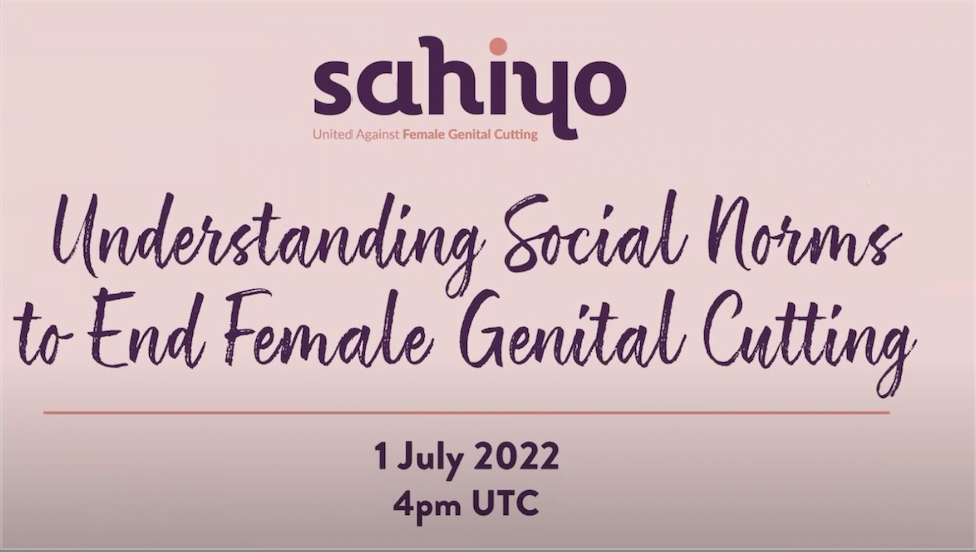Sahiyo hosted the webinar Understanding Social Norms to End Female Genital Cutting on July 1st. The event was moderated by Sahiyo co-founder, and winner of the Chameli Devi Jain Award Aarefa Johari, and attended by distinguished guest speakers Molly Melching and Maryan Abdikadir. Maryan is a survivor and activist of female genital mutilation/cutting (FGM/C), who contributed to the Prohibition of FGM Bill in Kenya. She also participated in our 2022 Spring Voices to End FGM/C workshop. Molly Melching is the founder and creative director of Tostan, an NGO whose mission is to empower African communities by fostering and promoting community engagement in literacy, health, and human rights projects.
Social norms are a growing set of unwritten rules and standards, which are passed on generationally in communities and cultures. These norms are often indisputably followed by society, as they are viewed as “the right thing to do'' or dismissed with the notion of “this is how it is and should be.” FGC, although prohibited in many countries, continues to be practiced as a social norm wherein young girls, women, and those assigned female at birth (AFABs) are raised with the expectation that they must undergo the practice without having the autonomy to choose for themselves. Molly beautifully presented the three main factors to consider when classifying an action as a social norm: a reciprocal expectation within a reference group, which refers to the community of people the norms affect; positive and negative sanctions if the norm is followed versus not followed; and finally, value attached to the practice.
The webinar began with Maryan’s moving and powerful Voices to End FGM/C video The Verbal Cut. Maryan shared her story of learning and unpacking FGC as a social norm and described learning that FGC has no basis in Islam and is not followed by all Muslim women. Amongst many other myths, she was told that if she does not undergo the procedure, her prayers will not be accepted in her faith. When she understood that FGC is not beneficial to women, and that these false beliefs were passed on to keep the practice in place, she decided against it for her daughter. Her daughter was shamed, ridiculed, and questioned for not undergoing FGC. Maryan’s video highlighted that even if some women decide to not follow the practice, this decision can still hurt them, which aligns with the norm that women’s value in practicing communities is determined by whether she is cut or not.
FGC continues in so many communities due to the social norms that perpetuate it. As an outsider that does not belong to the community, Molly explained how informing people about the consequences of FGC in a non-judgemental, respectful manner can be very effective in facilitating conversations about abandoning the practice as a community. As part of Tostan’s human rights program, FGC survivors who have abandoned the practice approach leaders of practicing communities and facilitate conversation about the harmful health impacts of FGC. Following weeks to months of deliberation through community engagement, the community makes a final declaration.
A considerate and respectful approach when talking about FGC may sound like using preferred terminology, such as “cutting’’ instead of “mutilation’’. Using vocabulary with harmful implications can be discouraging as words like “mutilation” can imply an intent to harm. However, Maryan, who belongs to the Somali community, prefers to use the term mutilation as she believes this term describes her experience with the practice. As outsiders, it is important to be aware of preferred terms when referring to FGC in order to accommodate and respect community and survivor experiences. As part of Molly’s activism, she continues to demystify myths associated with FGC, and terms considered taboo in order to facilitate effective conversations.
Some countries, like the US, have named FGC as a punishable offense and a violation of the law, while some countries are yet to acknowledge FGC as punishable. Maryan and Molly agreed that the law helps as a fallback option, but also believe that it is barely a solution. However, Molly maintained that the law is often mentioned in conversation by survivors who abandoned the practice. This is helpful, as it provides a strong argument for both why the practice needs to be abandoned, and why there is a reason for laws against FGC. While it helps back up FGC as a harmful practice, education and community engagement are some of the most important approaches to ending FGC and dismantling it as a social norm.
This webinar helped me understand how social norms can range from the simplest of societal expectations to life threatening consequences. Unwritten rules are ingrained so rigidly in society that it is difficult to notice them around us. This especially came to mind when Maryan mentioned she would have never thought to question FGC without finding out that her friend did not undergo the practice. It opened my eyes to silent norms present in communities around the world, which have the power to continue cycles of oppression in race and gender as we see today. It is important for us as a society to question harmful social norms and how we can shift them in a manner that uplifts voices around us to eventually break these cycles.
Watch the webinar here.
Read the webinar transcript here.

